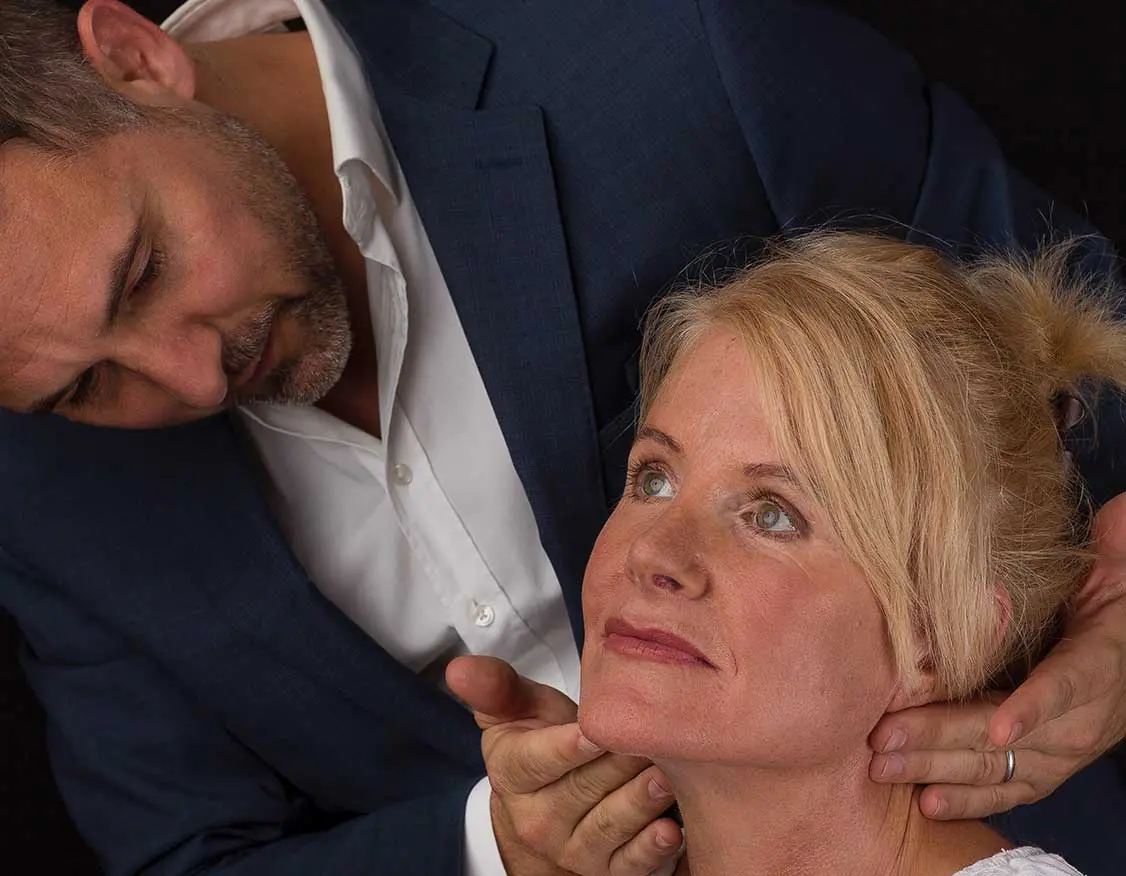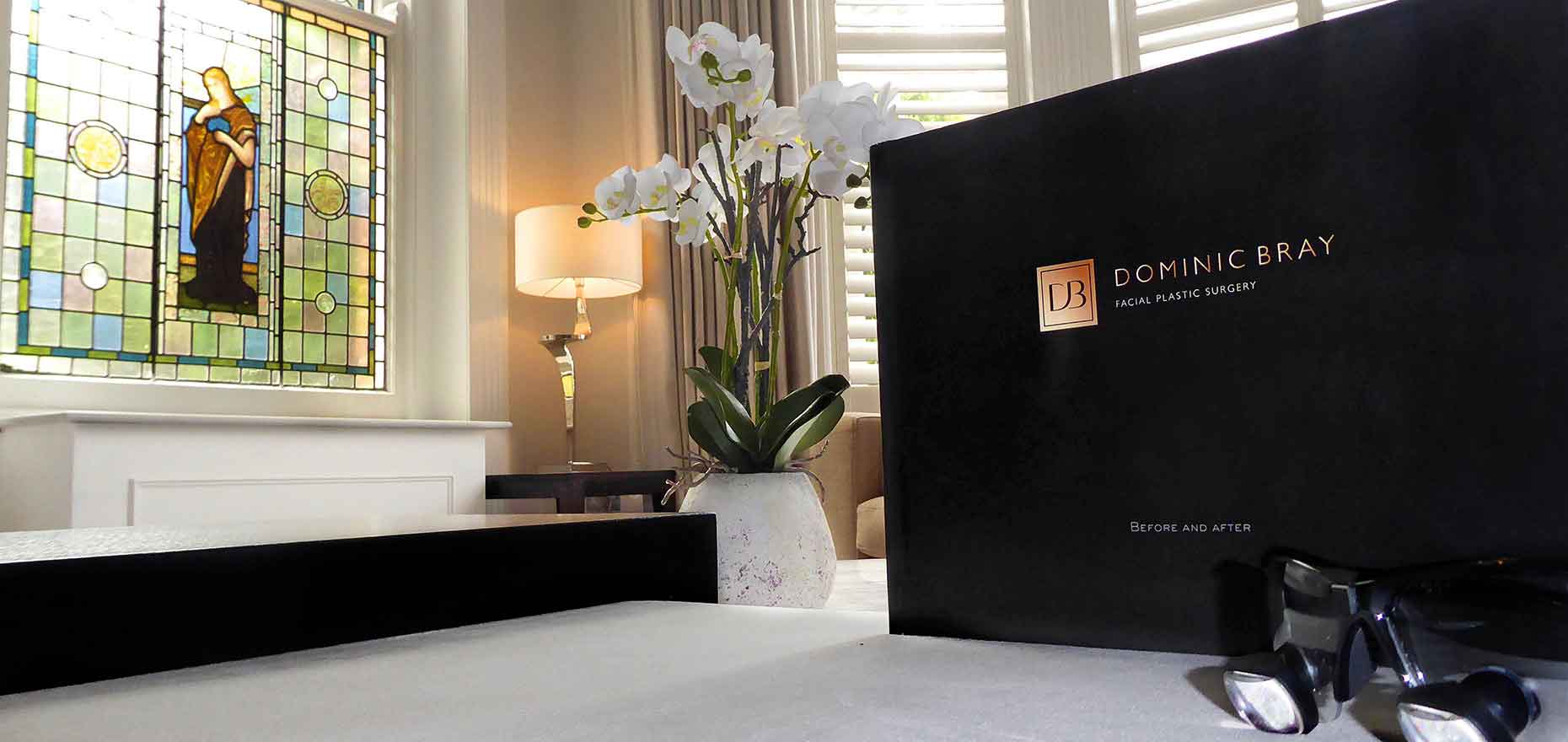How long does it take to recover from a facelift?
Facelift is major surgery that produces profound change but inevitably also has a lengthy period of recovery.
For many, this will be a prime consideration, perhaps the pay-off to be considered. The surgery might lead to the long-term change that is desired, a more youthful, vibrant appearance, but can the recovery period be lived through?
Is it too big a burden?

In this page, we will provide completely open and honest information from leading surgeon Dominic Bray, a cosmetic surgeon who specialises purely in face and neck procedures.
There is no intention to sugar coat, or play down the period of recovery. It does take time, it is challenging and it may not be for everyone. It is important that anyone considering a facelift is fully informed so that they can make the decision that is right for them.
Recovery is also more than just the first stages of physical recovery, it is also emotional recovery. At what stage does the patient feel back to normal, when do they feel that the operation and expense was completely worth it? How does this vary by patient, because clearly there is no set time after which everyone will feel fully recovered.
We also include information on how to prepare for recovery, how to ensure it goes smoothly and the stages of recovery you are likely to go through. It is not a steady process, you will go through emotional swings and so it is very useful to know these are coming and so not be surprised.
Recovery From Facelift – The Short Answer
We prefer to show the full process of recovery, but appreciate that many just want a quick, oversight type answer.
A realistic timeframe for full recovery is three months.
By this stage, swelling should have passed and you are completely delighted with your new appearance. There is no longer any visible look of ‘work having been done’ results – assuming the surgery was by a leading surgeon – look natural.
With the physical signs of healing faded, most patients will also be emotionally recovered, indeed elated by the process.
By this stage, you will also be able to resume all activities.
Life is back to normal.
Putting Recovery Time Into Context
The recovery period should not be understated – a period of around three months is undoubtedly a good chunk of time, though it is worth noting that patients are likely to be mostly recovered some time before this.
Many, for instance, will feel confident to resume most of their normal life after just a few weeks.
Put this figure into comparison with how long people CONSIDER facial surgery before doing anything about it – even booking that initial consultation. Research shows that the average is often around four years, that is four years of wondering about the benefits. It is four years where there is clearly some unhappiness about appearance.
And often these feelings won’t go away.
If surgery is the best option, and it won’t always be, then the period of recovery must be compared to this period of uncertainty and considering surgery. Three months is just one sixteenth of four years.
The three months is also three months to improvement, a definite end to the process, compare this to years of doubt dragging on.
For those for whom surgery is truly suitable, it is a relatively short period of time towards that better version of yourself.
Pace of Recovery From Facelift Surgery
Recovery is different for everyone, it is not a race or a competition.
There should not be any concern if you are slightly behind a generalised timeframe. If you are a bit ahead of schedule, that is to be welcomed.
Pre Facelift Surgery
Whilst it is easy to think of recovery purely post surgery, there is actually much that can be done prior to the operation to aid recovery.
Dominic Bray makes this a key part of his holistic approach to recovery.
Preparing for facelift is much like preparing for a holiday – in the same way as better holiday preparation reduces stress and makes the whole trip better, so too this can be said for surgery.
Post surgery, there will be recovery. Clearly it is best to prepare for this, both in terms of your diary, and also emotionally.
Dominic Bray tells patients to give them two weeks of their time, two weeks until they are comfortable to be visible socially and professionally.
This involves clearing the diary both of work and social commitments. There are numerous logistical steps to be taken – making sure you have childcare sorted, there aren’t chores around the house that will drive you crazy, even that you have bags of frozen peas in to help with swelling.
You don’t want to feel you have to rush recovery, a worry that you have a commitment in 10 days’ time you may have to cancel.
Emotionally, it is also important to approach recovery with a positive frame of mind. This extends to not Googling all the worst case scenarios, looking for scare stories.
Dominic Bray will inform you of all risks, and will also be available to answer any queries during the recovery. If you have a question, ask him, not Dr. Google.
The Stages of Facelift recovery
Recovery is not a steady process where you will feel gradually better and better. Instead, it goes through waves.
Whilst the precise journey for any patient will vary, it will typically follow a pattern similar to the below.
This timeframe is also for Dominic Bray’s patients. It is worth noting that he performs facelifts under local anaesthetic, whereas most surgeons use general. Mr Bray’s approach only has benefits – the surgery is not painful, the patient is still fully numbed and sedated as needed, but recovery is far easier.
The patient can literally walk out of the operating room and begin recovery without the awful feeling of coming round from general anaesthetic.
The initial stages of recovery, immediately post surgery, would be different under general anaesthetic.
Immediately post facelift and Day One
There can be a feeling of elation, you have had the surgery, the more youthful, vibrant appearance is now just a short recovery away.
You are likely to be able to walk out of the operating theatre and into your suite, where awaits a super king bed, with multiple soft pillows.
The suite is stocked with soft, sweet foods for those who feel hungry post surgery. Some will sleep, others feel less tired.
Overnight, the anaesthetic will wear off and the patient would feel some tightness. This is to be expected and can typically be managed through standard painkillers.
Nausea only occurs in around 10% of patients.
The next morning, patients tend to feel delighted. They are sore, but not in pain. This is going to be easy, they might think
Days Two and Three of Recovery
Mood typically changes over these days, though being aware this will happen helps to mitigate the impact.
Swelling increases and with this comes greater discomfort, the swelling can be sizeable for some.
The face may look alien, feel heavy and throb, there is likely to be a deeper soreness and tightness and it may be difficult to turn the head or open the mouth wide.
This can be a tough period. It is a time to take it very easy and allow yourself to be tired. Rest assured, it will pass in a day or two.
Remainder of First Week
Across the rest of the first week, the swelling will subside, but the patient is still likely to be some way from feeling like they want to be out and about and resuming normality.
Boredom can kick in, though after numerous Covid-19 lockdowns, perhaps we are all now better at keeping ourselves busy around the house.
There may be some lumps, and areas of skin may also feel numb. Some do make a first trip out at this stage, perhaps to the shops, typically with a hood up to hide the most visible signs of healing.
Into the Second Week
The stitches can come out now, this feels like a welcome step in the recovery. It can also relieve some discomfort as stitches may have been getting tighter by this stage,
The swelling typically descends down the face, and this can create a temporary double chin – don’t worry, we haven’t introduced a new problem.
Facial skin is still numb.
This week is partially just a continuation of the previous few days, feeling gradually better, swelling subsiding and the stage where you can be out and about ever closer. In fact, it’s only days away now.
Into week three
There is now daily improvement and at some stage you may well feel confident to go and brave the outside world a bit more.
Feeling can come back to areas, though this may create an initial feeling of pins and needles.
By this stage, while you are likely to still be very aware of facial swelling, you will be surprised how little others would notice it. In all likelihood, they would instead notice your improved features, getting a sense that you look better, but not quite able to put their finger on why!
Into week four
This is a landmark week as most will return to work at this stage and feel confident to meet friends and family who they hadn’t told about their operation.
You may worry that they will notice, and then actually be disappointed that they don’t!
In fact, they have noticed something different, that you look great, more vibrant, refreshed, but they can’t articulate why. This surely better than them commenting that you look like you’ve had cosmetic surgery!
You will still feel some tightness but this is fading.
After a month
By this stage, although there may be two more months of recovery, you are almost there.
The final recovery is slower, with smaller gains. Much of the obvious recovery has occurred by now.
Most swelling has subsided, and the swelling that remains can actually add a more youthful feel and appearance to skin. Areas that were numb are regaining feeling.
Confidence is growing by the day, you feel you can have any hairstyle and make-up is to add to your appearance, not to try to hide visible reminders of surgery.
After two months
Although recovery is ongoing, you will stop thinking about it, days going by in which you don’t give it much thought.
Feeling will be back for many and scars are barely visible by now.
Numbness is almost gone, and fading by the day and so too swelling. In fact, some miss the swelling as it gave a youthful glow – if this is the case, some filler can be used.
You will be glowing from the many compliments. You are now confident in your appearance.
After three months
You look wonderful!
The face is healed, the transformation from before surgery complete.
All swelling has now gone and your skin is looking radiant, the prescription skincare prescribed by Dominic Bray having a clear impact.
In almost all cases – 99% – scars are now invisible.
You will have forgotten you have had a facelift, in fact you will forget what you used to look like. This is how I’ve always looked, isn’t it?
This is the new you. Enjoy!
Next Steps
It is important to consider facial surgery and full facelift armed with all information and facts. It is to be applauded that you are seeking out details of the recovery process, as many neglect to think about this.
They think of the before, they think of the benefits, but not the process in-between the two.
It cannot be taken lightly. The recovery is challenging, but the stages when you feel at your worst pass quickly. They also pass far more readily if you know they will pass.
The process is also far more straightforward if you have prepared, got things in order so that you can rest up and relax.
Finally, the recovery process will vary by surgeon. It is worth noting that Dominic Bray stands apart. His bespoke hospital is designed to the highest of standards, his patient care in unmatched. Recovery will still be a challenge at times, but he will make it a far easier challenge.
How Dominic Bray Differs
There are many plastic surgeons so why consider Dominic Bray?
His results are stunning, as you can see from the before and after image gallery.
These results are achieved because Dominic specialises, whereas many cosmetic surgeons are allrounders and perform a huge range of procedures on all parts of the body, he has chosen to specialise and dedicate himself to facial and neck surgery.
As a result, everything he does is geared towards procedures such as neck lifts, from his skills, through to the team he works with and even the facility whereby you would undergo surgery .
Patients benefit from a private, dedicated hospital set up by Dominic rather than leased space in a large private hospital.
– Dominic’s CV is stunning and you can read more about him on this site through a detailed resume and also information on his ethos. A few key points are listed below
– Dominic has stunning, independent reviews. Please take the time to read testimonials – and do this for any surgeon you may consider. He has more than 200 independent, verified reviews and almost without exception these are for 5 stars.
– Dominic was the first UK surgeon to be invited to sit on an expert panel to discuss management of facelift complications at the American Academy of Facial Plastic Surgery annual meeting.
– A significant proportion of his work is with patients referred for revision surgery – improving the flawed work of other surgeons.
– His qualifications, training, prizes, memberships and publications stand comparison with any. You can see full details on the About Page.
– Dominic has undertaken specialist higher training in Otolaryngology – face and neck surgery. There are many cosmetic surgeons who perform neck lifts as part of what they offer – for Dominic this is his specialism.
Please take the time to get a sense for Dominic and his ethos. If you have any further questions or would like to arrange a consultation, do not hesitate to get in touch.
Call us on 0203 417 9980 or use the Contact Form.


Considering
Facelift Surgery?
The definitive guide to anyone considering facelift and neck lift surgery at our London or Tunbridge Wells locations. Essential research for potential patients.
Read this first




